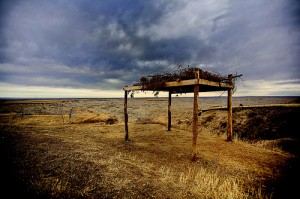In these days of increasing eco-conscious, less-is-more aestheticism, many of those preparing for an end-of-life are beginning to question the need for elaborate caskets, garish flower displays and environmentally unsound cemeteries. Home funerals too, that is, the family keeping, cleaning and preparing the body of their loved one in their own home, are becoming more common. In a sense, this trend suggests a return to the old ways, when it was commonplace for families to see to their own dead and bury them in plain wood caskets with plain wood markers. However, if mainstream America is only just now heading back in this direction, there are many Native American tribes that never strayed far from it in the first place.
There are over 500 different Native American tribes across the continent, about 1.9 million people altogether, and, of course, burial customs vary widely and have gone through many changes, be it through geographic displacement, the influence of outside cultures, or simple changing tastes. In the pre-colonial days, different tribes maintained different customs appropriate to their regional environment — for instance, nomadic Great Plains tribes would bury their dead if the ground was soft, or sometimes leave them in trees, on simple platforms or scaffolds that would support their remains. The Iroquois in the Northeast would save the bones of their dead for a final mass burial, and would equip them with furs and tools for use in the after-life — Indian Burial Mounds were once a common sight in Arkansas, the Mississippi River Valley and other parts of the Eastern U.S., though, unfortunately, many were destroyed during the 19th and 20th centuries, and today many more are threatened by the forces of development. American Indian tribes would defend their burial sites and practices fiercely, and even today disposition practices on Indian reservations has been a source of friction between tribal federations and the Federal government.
But while beliefs and traditions vary widely from tribe to tribe, like religious practices and death rituals the world over, the similarities are perhaps just as striking. In most cases the dead would be cleansed or purified in some manner, and whether they were cremated, buried, or interred in a wood or adobe tomb, the dead were handled with respect, and separated from the living. And one further common thread in American Indian beliefs: an overarching respect for Mother Nature; the earth, the sky, the trees and the animals. An acceptance of our oneness with all that is around us. Indeed, one could say that they kept hold of a form of knowledge that more urbanized peoples tried so hard to forget, and are now perhaps coming to recall: that, like it or not, we humans are a part of nature. We suffer from illness, we adapt to changes in the climate. When we die, our bodies decompose, and we become a part of that which we came from. Our biological material is recycled and re-distributed, and, in a small way, even if we do not believe in an afterlife, we live on as our biological matter, the sum total of our lifetime’s experiences, is reabsorbed into the cycle of life. Perhaps, we can try to find some comfort in this.
- SevenPonds reviews the recent film, Beasts of the Southern Wild.
- Discover Hindi death rituals, and how they relate to our own practices here and now.
- Learn how children handle death, and how we can communicate with them effectively and lovingly.

 What American Indian Burial Rituals Can Teach Us
What American Indian Burial Rituals Can Teach Us




 First the Wealth Gap, Now the U.S. Has a Growing Health Gap
First the Wealth Gap, Now the U.S. Has a Growing Health Gap
 How to Comfort A Dying Loved One
How to Comfort A Dying Loved One
 Our Annual Seven Holiday Gifts for Someone Who Is Grieving, 2024 Edition
Our Annual Seven Holiday Gifts for Someone Who Is Grieving, 2024 Edition














